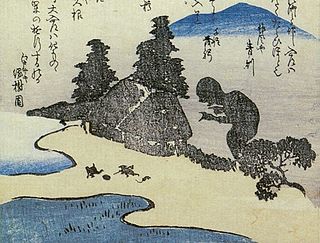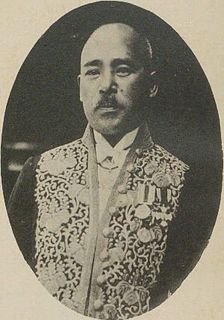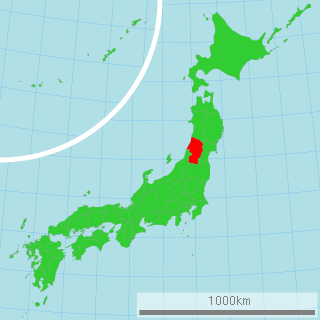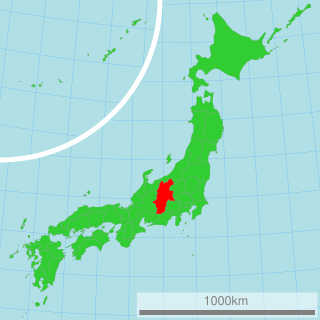
The bakeneko is a type of Japanese yōkai, or supernatural creature. According to its name, it is a cat that has changed into a yōkai. It is often confused with the nekomata, another cat-like yōkai, and the distinction between the two can often be quite ambiguous.

Funayūrei are ghosts (yūrei) that have become vengeful ghosts (onryō) at sea. They have been passed down in the folklore of various areas of Japan. They frequently appear in ghost stories and miscellaneous writings from the Edo Period as well as in modern folk customs. In the Yamaguchi Prefecture and the Saga Prefecture, they are called Ayakashi.
Kenichi Yamamoto was a Japanese cross-country skier who competed in the 1950s. He finished 22nd in the 18 km event at the 1952 Winter Olympics in Oslo.

Xialu District is an administrative district of the prefecture-level city of Huangshi, Hubei province, People's Republic of China. It is a fairly small industrial and residential district, located to the west of Huangshi's downtown Huangshigang District. Since changes in May 2011, the district has been divided into four township-level divisions.
"Jidai" (時代) is a 1975 song by Miyuki Nakajima. She redubbed it in 1993 for her album Jidai: Time Goes Around. A popular cover was also released by Hiroko Yakushimaru in 1988. Hayley Westenra translated it and sung it in Hayley Sings Japanese Songs in 2008. An instrumental version was used in the opening credits of Leiji Matsumoto's series CosmoWarrior Zero.

Chōchinbi is a type of onibi, told in legends in each area of Japan.

Ōnyūdō is a yōkai told about in parts of Japan.
The Shichinin misaki, which means "7-person misaki," are a group of ghosts first known in Kōchi Prefecture, told about in the Shikoku and Chūgoku regions.
Maruoka Kanji was Governor of Okinawa Prefecture (1888–1892) and governor of Kōchi Prefecture (1892).

Kinjiro Nagai was Director of the Karafuto Agency. He was also mayor of Otaru and Governor of Kōchi Prefecture (1913–1914).

Masao Kishimoto was Director of the Karafuto Agency. He was Governor of Akita Prefecture (1922–1924), Yamagata Prefecture (1924), Okayama Prefecture (1927–1928) and Hiroshima (1928–1929).

Kodama Kyūichi was a Japanese Home Ministry government official and politician.
Inada Syūichi was a Japanese Home Ministry government official and politician. He was born in Niigata Prefecture. He was a graduate of the University of Tokyo. He was governor of Shiga Prefecture (1945–1946). He was Grand Chamberlain of Japan (1965–1969).
Noriyuki Kazaoka was Grand Steward of the Imperial Household Agency from 1 Jun 2012 – 26 Sep 2016. He was born in Niigata Prefecture.

Yamawaro or yamawarawa (山童) is a yōkai that appears in mountains that is told about in Western Japan, starting in Kyushu. Sometimes it is said that they are kappa who have come to dwell in the mountains. In the Ashikita District, Kumamoto Prefecture, in addition to "yamawaro," it is also called "yamawarō", "yamamon", "yamanto", "yaman wakkashi", and "yaman ojiyan". Also, in the Kuma District of the same prefecture, they can also be called "yaman-tarō" (山ん太郎) or "yamanbo" (山ん坊).
Tsurara-onna is a Japanese folklore. It is a tale about an icicle that became a woman, so it is often confused with yuki-onna.

Morio Takahashi was a Japanese politician. He was born in Kumamoto Prefecture. He was a graduate of the University of Tokyo. He was mayor of Kumamoto (1922-1925) and governor of Shiga Prefecture (1925-1926), Nagano Prefecture (1926-1927) and Hyōgo Prefecture (1929-1931). In 1931, he served in the Government-General of Taiwan. He served as Superintendent General in 1934.
Norikichi Oshikawa was a Japanese politician. He was born in Kagoshima Prefecture. He was governor of Yamagata Prefecture (1897-1898), Ōita Prefecture (1898-1899), Nagano Prefecture (1899-1902), Iwate Prefecture (1904-1907) and Kumamoto Prefecture (1907-1908). He was a member of the Government-General of Taiwan. He was a recipient of the Order of the Rising Sun and the Order of the Sacred Treasure.
Teikan Chiba was a Japanese prosecutor, judge and politician. He was born in Nara Prefecture. He was governor of Ōita Prefecture (1906-1911) and Nagano Prefecture (1911-1913). He was a recipient of the Order of the Sacred Treasure.
Minoru Suzuki was a Japanese politician. He was born in Shizuoka Prefecture. He graduated from the University of Tokyo. He was governor of Aomori Prefecture (1939-1940) and Nagano Prefecture (1940-1942). He was mayor of Kure, Hiroshima (1942-1946).













